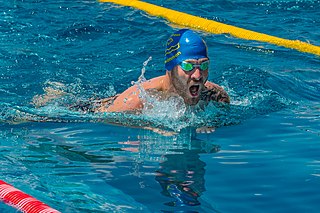
Swimming is the self-propulsion of a person through water, or other liquid, usually for recreation, sport, exercise, or survival. Locomotion is achieved through coordinated movement of the limbs and the body to achieve hydrodynamic thrust that results in directional motion. Humans can hold their breath underwater and undertake rudimentary locomotive swimming within weeks of birth, as a survival response.
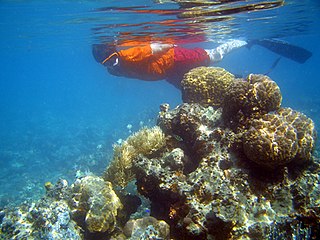
Snorkeling is the practice of swimming on or through a body of water while equipped with a diving mask, a shaped breathing tube called a snorkel, and usually swimfins. In cooler waters, a wetsuit may also be worn. The use of this equipment allows the snorkeler to observe underwater attractions for extended periods with relatively little effort and to breathe while face-down at the surface.

A dry suit or drysuit provides the wearer with environmental protection by way of thermal insulation and exclusion of water, and is worn by divers, boaters, water sports enthusiasts, and others who work or play in or near cold or contaminated water. A dry suit normally protects the whole body except the head, hands, and possibly the feet. In hazmat configurations, however, all of these are covered as well.

An air mattress is an inflatable mattress or sleeping pad.

A buoyancy compensator (BC), also called a buoyancy control device (BCD), stabilizer, stabilisor, stab jacket, wing or adjustable buoyancy life jacket (ABLJ), depending on design, is a type of diving equipment which is worn by divers to establish neutral buoyancy underwater and positive buoyancy at the surface, when needed.
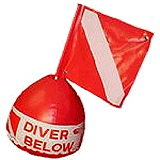
A surface marker buoy, SMB, dive float or simply a blob is a buoy used by scuba divers, at the end of a line from the diver, intended to indicate the diver's position to people at the surface while the diver is underwater. Two kinds are used; one (SMB) is towed for the whole dive, and indicates the position of the dive group throughout the dive, and the other, a delayed surface marker buoy, DSMB or decompression buoy, is deployed towards the end of the dive as a signal to the surface that the divers have started to ascend, and where they are going to surface. Both types can also function as a depth reference for controlling speed of ascent and accurately maintaining depth at decompression stops. Surface marker buoys are also used by freedivers in open water, to indicate the approximate position of the diver when submerged. They may also be used to support a catch bag or fish stringer by underwater hunters and collectors. A DSMB is considered by recreational scuba divers and service providers to be a highly important item of safety equipment, yet its use is not part of the entry level recreational diver training for all training agencies, and there are significant hazards associated with incompetent use.
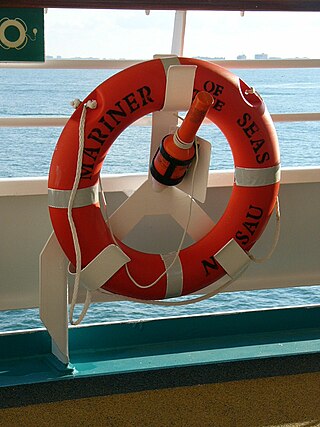
A lifebuoy is a life-saving buoy designed to be thrown to a person in water, to provide buoyancy and prevent drowning. Some modern lifebuoys are fitted with one or more seawater-activated lights, to aid rescue at night.

Drownproofing is a method for surviving in water disaster scenarios without sinking or drowning. It is also famous as a class once required at the Georgia Institute of Technology.
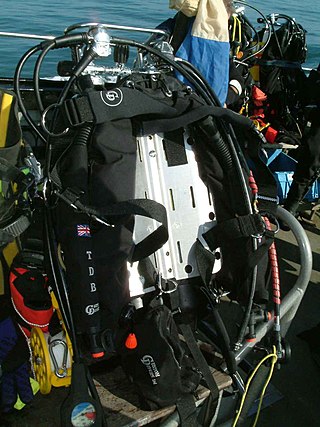
A backplate and wing is a type of scuba harness with an attached buoyancy compensation device (BCD) which establishes neutral buoyancy underwater and positive buoyancy on the surface. Unlike most other BCDs, the backplate and wing is a modular system, in that it consists of separable components. The core components of this system are:
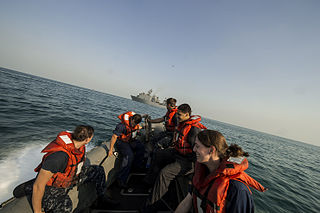
A personal flotation device is a flotation device in the form of a vest or suite that is worn by a user to prevent the wearer from drowning in a body of water. The device will keep the wearer afloat with their head and mouth above the surface – they do not have to swim or tread water in order to stay afloat and can even be unconscious.
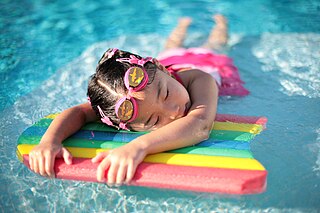
A swimming float, commonly known as pool float or floaty, is a device used for toddlers or other very young children who are beginning to learn how to swim, or during exercise for therapeutic or training purposes. These devices, which come in many shapes and types, are used to aid them with buoyancy, or for floating on for fun.
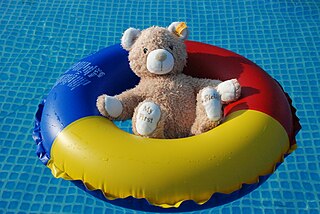
A swim ring is a toroid-shaped inflatable water toy. The swim ring was derived from the inner tube, the inner, enclosed, inflatable part of older vehicle tires. The inner tube, when inflated, was used as a water toy, and as a floating object to lounge on.

The Davis Submerged Escape Apparatus, was an early type of oxygen rebreather invented in 1910 by Sir Robert Davis, head of Siebe Gorman and Co. Ltd., inspired by the earlier Fleuss system, and adopted by the Royal Navy after further development by Davis in 1927. While intended primarily as an emergency escape apparatus for submarine crews, it was soon also used for diving, being a handy shallow water diving apparatus with a thirty-minute endurance, and as an industrial breathing set.
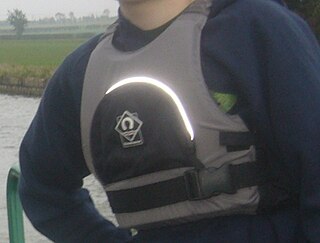
Buoyancy aids are a specialist form of personal flotation device (PFD) used most commonly by kayakers, canoeists, people practicing rafting, and dinghy sailors. They are designed as a flotation aid, rather than merely a life-saving device and have several key differences to other PFD's and lifejackets. Some buoyancy aids may not provide the same high level of protection as lifejackets.

A survival suit, more accurately and currently referred to as an immersion suit, is a type of waterproof dry suit intended to protect the wearer from hypothermia if immersed in cold water or otherwise exposed after abandoning a vessel, especially in the open ocean. Immersion suits usually have integral footwear, and a hood, and either built-in gloves or watertight wrist seals. Suits manufactured by several manufacturers also include an inflatable pillow which is permanently attached high on the back, or an inflatable tube that is attached with zippers at two points on the chest, each side of the main zipper, and circles the back. When inflated, both of these devices provide enhanced stability to the wearer, which, if conscious, allows them to keep the head above water, and to keep wind and seas from striking the face. The inflation tube is routed from the inflatable pillow over the left shoulder of the user, and secured in a loop on the chest.
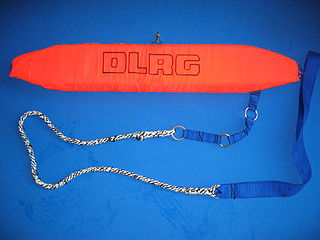
A rescue buoy or rescue tube or torpedo buoy is a piece of lifesaving equipment used in water rescue. This flotation device can help support the victim's and rescuer's weight to make a rescue easier. It is an essential part of the equipment that must be carried by lifeguards. It further can act as a mark of identification, identifying an individual as a lifeguard.

Zoggs is a brand of swimming goggles, training aids, swimwear and other related products. The company launched in Sydney, Australia in 1992 and was the first brand to offer UV protection and split yoke straps as standard features on all goggles.
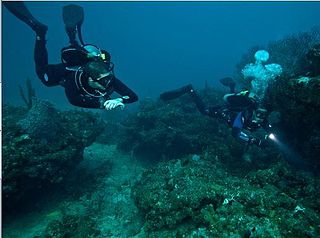
The trim of a diver is the orientation of the body in the water, determined by posture and the distribution of weight and volume along the body and equipment, as well as by any other forces acting on the diver. Both static trim and its stability affect the convenience and safety of the diver while under water and at the surface. Midwater trim is usually considered at approximately neutral buoyancy for a swimming scuba diver, and neutral buoyancy is necessary for efficient maneuvering at constant depth, but surface trim may be at significant positive buoyancy to keep the head above water.

Scuba skills are skills required to dive safely using self-contained underwater breathing apparatus. Most of these skills are relevant to both open-circuit scuba and rebreather scuba, and many are also relevant to surface-supplied diving. Certain scuba skills, which are critical to divers' safety, may require more practice than is provided during standard recreational training.



















